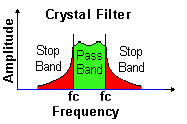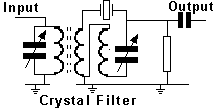The crystal filter:
Crystals can be used in
filters and the diagram below gives an example of its use.
Such filters are commonly used at intermediate frequencies
above 500kHz.
 
Note the use of the Xtal in the diagram and that the
core of the transformer has dotted lines to indicate that it
is a iron dust core

Above is
the diagram of another type of crystal filter
The
crystal filter uses a piece of quartz crystal exactly like a
typical crystal used for stable frequency generation. The
crystal is usually combined in a circuit with inductors and
capacitors to give an impedance match between the stages of
amplification that the filtering is applied to.
In
practice, because a single crystal is a very high "Q" device
(and hence possesses a very narrow bandwidth), it is usual to
build a crystal filter that incorporates several crystals.
These crystals are all carefully chosen such that they are not
all on the same frequency, but spread on, and around the
centre frequency of the filter.
In this
way, a wider bandwidth for the filter may be obtained, whilst
still maintaining the very steep "sides" of the filter
characteristic.
Unlike a
conventional inductor/capacitor filter, where energy is stored
magnetically in the inductor, and electrostatically in the
capacitor, the crystal filter actually mechanically vibrates
at the marked frequency. It works very much in the same way as
a tuning fork, except that the frequency of operation is very
much higher. As an example, if the filter is designed for 10.7
Mhz, then the crystal elements within the filter are actually
vibrating mechanically at 10,700,000 times every second!
ΔΔAn
alternative to the crystal filter is the mechanical filter.
These are not usually designed to operate much beyond 0.5Mhz,
and their mode of operation is very similar indeed to the
crystal filter. These filters possess an even sharper skirt,
and where cost is not an issue, and design limitations allow,
prove to be a superior choice.
For
budget applications, a ceramic filter is a low cost
alternative. Performance of this type is not as good as the
crystal filter, but it does allow a very useful filter to be
constructed for the lower frequencies, whilst being suitable
for miniaturization.
------------------------------------------------------------------------------------------
3E2 continued and Calculate
relevant frequencies.
For
calculations the formula from the formula sheet is  which stand for :- which stand for :-
bw
= bandwidth AFmax = Maximum Audio
Frequency Δf = peak deviation
So
if you were given a peak deviation of 5kHz and maximum audio
frequency of 3.5kHz the band width (bw) would be
bw
= 2( 5 +3.5) = 2( 8.5) = 17Khz
|